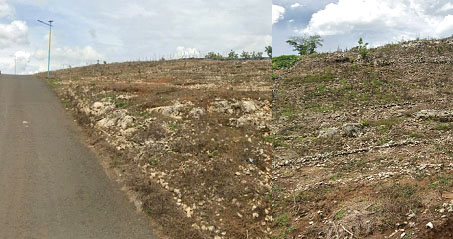Analisis “Kegagalan” Pendaftaran Tanah Sistematis Lengkap di Kabupaten Pati
DOI:
https://doi.org/10.31292/mj.v2i1.29Keywords:
PTSL, Cluster 3, Land administration, PTSL refusalAbstract
Cluster 3 is a product of the Complete Systematic Land Registration/ Pendaftaran Tanah Sistematis Lengkap (PTSL) where physical data collection has been carried out on PTSL objects, but the certificate cannot be issued due to several reasons behind it. Cluster 3 in the implementation of PTSL in Pati Regency is 83,873 fields, this number is an accumulation of cluster 3 within a period of three years, namely from 2019 to 2021 and there has been no significant effort made by the Pati Regency Land Office to suppress or solve the cluster 3 problem. The method used in this study is a qualitative method with observation and interview. The results of research that has been carried out in two villages in Pati Regency, namely Prawoto Village and Wegil Village show that the factors causing cluster 3 in the implementation of PTSL are unproductive soil conditions, the delivery of information on the implementation of PTSL that is not on target to the community, there is a concern for the community towards the land program. Another thing is that the ease of access to capital (without land certificates) in banks contributes to the refusal of people to be involved in PTSL. The author concludes that the state should take more appropriate approaches regarding the needs and guarantees of legal certainty over residents' land, because the legalization of assets in addition to the state's need to map all land is also to be able to guarantee the certainty of land owned by the community.
Downloads
References
Amajihono, K. D. (2018). Ganti Rugi Masyarakat Atas Pelepasan Hak Atas Tanah Untuk Kepentingan Umum. Jurnal Education and Development, 5(Vol 5 No 1 (2018): Vol.5. No.1 Juli 2018).
Anjany, D. T. T. A. S. (2019). Arti Penting Pendaftaran Tanah demi Menjamin Kepastian Hukum (Studi di Kelurahan Meteseh Kecamatan Tembalang Kota Semarang). Diponegoro Law Journal, 8(1).
Ardian, D. Y., Defit, S., & Yunus, Y. (2020). Identifikasi Potensi Daerah Menggunakan Metode K-Means Clustering pada Pendaftaran Tanah Sistematis Lengkap. Jurnal Informasi Dan Teknologi. https://doi.org/10.37034/jidt.v2i4.106
Artika, I. G. K., & Utami, W. (2020). Percepatan Pembenahan Data Bidang Tanah Kluster 4 melalui Survei Data Pertanahan. BHUMI: Jurnal Agraria Dan Pertanahan, 6(1). https://doi.org/10.31292/jb.v6i1.425
Creswell, J. W. (2016). Research Design: Pendekatan Metode Kuantitatif, Kualitatif, dan Campuran (A. F. & R. K. P. (Penerjemah), Ed.; Keempat). Pustaka Pelajar.
Ishaya, N. S., Budhiawan, H., & Widarbo, K. (2021). Implementasi Hak Servituut pada Pelaksanaan Pendaftaran Tanah Sistematis Lengkap di Kabupaten Bekasi. Marcapada: Jurnal Kebijakan Pertanahan, 1(1). https://doi.org/10.31292/jm.v1i1.6
Jannah, W., Salim, M. N., & Mujiburohman, D. A. (2022). Eksistensi Masyarakat Hukum Adat dan Dinamika Tanah Ulayat di Manggarai Timur. Jurnal Ilmu Sosial Dan Humaniora, 11(2).
Kartono, S. A. (2020). Politik Hukum Pertanahan Dalam Rangka Percepatan Pendaftaran Tanah Di Indonesia. Esensi Hukum, 2(1). https://doi.org/10.35586/esensihukum.v2i1.17
Kurniawan, W. A., Setiowati, S., & Supriyanti, T. (2018). Ekspektasi Pendaftaran Tanah Sistematis Lengkap Terhadap Faktor Sosial dan Ekonomi Masyarakat. Tunas Agraria, 1(1). https://doi.org/10.31292/jta.v1i1.1
Lestari, T., Budhiawan, H., & Nurasa, A. (2020). Desa Taruba dan “penolakannya” Terhadap Program Pendaftaran Tanah Sistematis Lengkap. Tunas Agraria, 3(1), 200–217. https://doi.org/10.31292/jta.v3i1.74
Marryanti, S., & Purbawa, Y. (2019). Optimalisasi Faktor–Faktor Yang Mempengaruhi Keberhasilan Pendaftaran Tanah Sistematis Lengkap. BHUMI: Jurnal Agraria Dan Pertanahan, 4(2), 190. https://doi.org/10.31292/jb.v4i2.278
Neuman, W. L. (2013). Metode penelitian sosial Pendekatan kualitatif dan kuantitatif (7th ed.). PT Indeks.
Poniskori, T. (2017). Pendaftaran Tanah Secara Sporadik Menurut PP Nomor 24 Tahun 1997 tentang Pendaftaran Tanah. Lex Privatum, 5(2).
Pujiriyani, D. W., Salim, M. N., & Soinbala, M. R. (2022). Agrarian Reform and Indigenous Peoples: Land Management Practices of Boti Tribe. Marcapada: Jurnal Kebijakan Pertanahan, 2(1), 64–73.
Raco, J. (2010). Metode Penelitian Kualitatif: Jenis, Karakteristik dan Keunggulannya. Grasindo.
Salim, M. N., Rineksi, T. W., & Wulan, D. R. (2022). Politik Kelembagaan Agraria Indonesia: Jalan Terjal Pembentukan Kelembagaan dan Kebijakan Agraria, 1955-2022. STPN Press.
Sibuea, H. Y. P. (2013). Tinjauan Yuridis Atas Pemanfaatan Ruang Di Bawah Tanah. Negara Hukum, 4(Land Reform), 18–34.
Silviana, A. (2019). Kebijakan Satu Peta (One Map Policy) Mencegah Konflik di Bidang Administrasi Pertanahan. Administrative Law and Governance Journal, 2(2). https://doi.org/10.14710/alj.v2i2.195-205
Solihat, M. (2008). Komunikasi Massa dan Sosialisasi. Mediator: Jurnal Komunikasi, 9(1). https://doi.org/10.29313/mediator.v9i1.1143
Sumartono, S., & Hermawan, H. (2020). The reform of public service bureaucracy in the investment sector within the pentahelix perspective: A new hope in the era of autonomy? Australasian Accounting, Business and Finance Journal, 14(1 Special Issue). https://doi.org/10.14453/aabfj.v14i1.4
Surayya, I. (2020). Idiologi Hukum Pendaftaran Tanah Dalam Sistem Hukum Agraria. Jatiswara, 34(1). https://doi.org/10.29303/jatiswara.v34i1.224
Suyikati, S. (2019). Pelaksanaan Pendaftaran Tanah Sistematis Lengkap (PTSL) Berdasarkan Peraturan Menteri Agraria dan Tata Ruang/Kepala Badan Pertanahan Nasional Nomor 6 Tahun 2018 di BPN Kota Yogyakarta. Widya Pranata Hukum: Jurnal Kajian Dan Penelitian Hukum, 1(2). https://doi.org/10.37631/widyapranata.v1i2.43
Tehupeiory, A. (2012). Pentingnya Pendaftar Tanah di Indonesia. RAS (Raih Asah Sukses).

Downloads
Published
How to Cite
Issue
Section
License
Copyright (c) 2022 Thezar Prymori Parenta

This work is licensed under a Creative Commons Attribution-ShareAlike 4.0 International License.

















